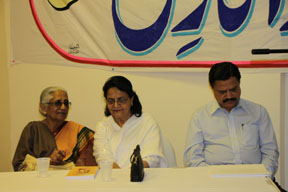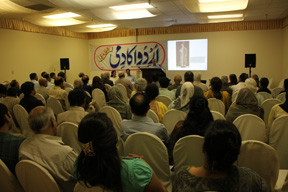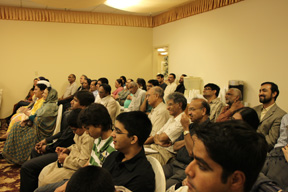|
By Abdus Sattar Ghazali
Urdu Academy’s June 21, 2009 literary evening was dedicated to the life and work of the great Urdu poet and prose writer Mirza Asadullah Khan Ghalib.
The event was held at the Chandni Restaurant in Newark, CA. Syed Sarwat Mahmood, owner of Chandni and a lover of Urdu literature, has offered the restaurant facilities for monthly programs of Urdu Academy.
The event was presided over by Vijay Nigam whose father, Ganga Dhar Nath Farhat Kanpuri, was a well known Urdu poet. His diwan was published under the title: Hawa Ka Jhonka. Ms. Shazi, a visiting poetess from Karachi was the chief guest.
The literary fans who presented Ghalib’s poetry included: Meraj Sultana Ghazali, Mohammad Saleem, Khalid Khokar, Sanjay Sethi, Asim Bajwa and Abdus Sattar Ghazali.
The 15-year-old, Master Osman Arshad, a 10th Grader, thrilled the audience with his perfect presentation of Ghalib’s ghazal: Kooi Ummeed Bar Naheen Aati, Kooi Soorat Nazar Naheen Aati. Osma’s father Arshad Rashid, who is a great fan of Urdu literature, has taught him Urdu. One of the objectives of the Urdu Academy is to encourage young generation to learn Urdu and Master Osman’s presentation was probably the outcome of Academy’s efforts.
It may be recalled that in Urdu Academy’s May 17, 2009 program the audience was impressed with the presentation of Zauq’s ghazal by the 15-year-old Simone Salman.
Dr. Tahir Mahmood, the MC of the event, gave a beautiful graphic presentation about Ghalib’s life and work. He showed some rare pictures on projector which amazed the audience.
Arshad Rashid in his maqala on Ghalib’s poetry and prose pointed out that Ghalib was not only a great poet but he was a trend setter for the Urdu prose. Nisar Shaikh talked about "Ghalib ki shairi mein Tanz-o-Zrafat" (Humor in Ghalib’s poetry). Jawed Umerani spoke about Ghalib’s Persian poetry.
Mirza Asadullah Khan Ghalib was born in 1797 at Agra, son a high-ranking army officer and descendent of the ancient Seljuq kings. At 13 he married a daughter of a Mughal nobleman and moved to Delhi. He enjoyed titles and annuities from the Moghul court, but was never far from poverty.
Ghalib’s period was one of political, religious and intellectual controversy, when oriental concepts were invaded by western rationalism, and the poetry is not primarily one of feeling but of sensuous expression of an uniquely perceptive, original and synthesizing mind. In this sense, Ghalib is a contemporary, and he employed many of the techniques of western modernism. In their different ways, Mir, Nazir and Ghalib are the masters of Urdu poetry.
Ghalib who is viewed as an ‘ustad’ of ‘ustads’ in Urdu poetry was a harsh judge of his own work. While compiling his ‘diwan’ he mercilessly discarded more than 2000 couplets which he considered sub-standard. This made the size of the anthology small but what was left touched the highest level of Urdu poetry.
Ghalib never saw affluence. He spent his life in poverty and indigence but he never compromised with his sense of self-respect. In time of extreme poverty, he accepted an offer to teach Persian in Delhi College. But he returned from the house of the British officer who had made the offer when he found no one to welcome him at the gate.
Ghalib was probably born at the wrong time because it was the period that the British were heavily involved in shaping the Indian literature replacing Persian language with English language as the official language of India. This policy affected Ghalib negatively especially that he continued to write in Farsi and wanted to be reckoned as the best Farsi poet of his time. It is a very little known fact to his Urdu poetry lovers that he created much more Farsi works than Urdu.
Though now a household name on the subcontinent, he died in Delhi in 1869, with achievements largely unrecognized.
Ghalib’s letters
Not only Urdu poetry but the prose is also indebted to Mirza Ghalib. His letters gave foundation to the easy and popular Urdu. Before Ghalib, letter writing in Urdu was highly ornamental. 
Tashie Zaheer, president of the Urdu Academy, spoke about Ghalib’s letter. Ghalib made his letters "talking" by using words and sentences as if he is talking to the reader. Tashie amused the audience with a few samples of his letters. According to Ghalib:
"sau kos say ba-zabaan-e-qalam baateiN kiya karo aur hijr meiN visaal kay ma-zay liya karo"
(From hundred of miles talk with the tongue of the pen and enjoy the joy of meeting even when you are separated.)
Ghalib’s letters were very informal, some times he will just write the name of the person and start the letter. He himself was very humorous and also made his letter very interesting. He wrote:
"maiN koshish karta hooN keH koi aisi baat likhooN jo pa-Rhay kHoosh ho jaaye"
(I want to write the lines that whoever reads those should enjoy it.)
When the third wife of one of his friends died, he wrote:
"Allah allah aik woH log haiN jo teen teen dafaH iss qaid say chhooT chu-kaiN haiN aur aik hum haiN keH aik ag-lay pachas baras say jo phaNsi ka phaNda ga-lay meiN paRha hai to naH phaNda hi TuT-ta hai naH dum hi nikalta hai"
(Allah Allah, there are some among us who have been freed from the prison three times and I have for the past 50 years this rope around my neck neither this rope breaks nor it takes my life.)
Tashie believes that Ghalib has a high place in the Urdu literature only on the basis of his letters. At the same time his letters serve as an invaluable chronicler of his turbulent period.
Musical renditions
The Urdu Academy literary events’ end tale is always maked with talented musical renditions. Dr. Anshuman Chandra amused the audience with his presentation of Ghalib’s ghazals on guitar. He presented the same ghazal in different voices of popular singers such as Akhtari Begum and Jagjeet Singh.
Nagesh Avadhany also captivated the audience with the presentation of two ghazals in classical tunes.
The program ended with the singing of Ghalib’s ghazals the ghazal maestro Kuldip Singh.
Waqar Ahmad Khan presented a vote of thanks.
More pictures
|